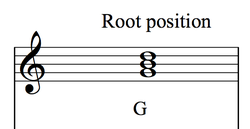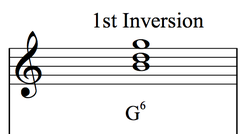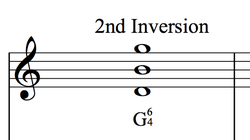Chord Inversions
Just like intervals, chords can be inverted. When we think about chord inversions, we will look at which of the 3 notes end up on the bottom: the root, 3rd, or 5th.
Root Position

If the root of the chord is in the bass, or the bottom of the chord, then we consider it to be in root position. When we label root position chords, we simply need to label the chord with the root and quality (major chords don't need major, just the capital letter)
1st Inversion

If the 3rd of the chord is in the bass, then we consider it to be in 1st inversion. When labeling 1st inversion chords, we add a superscript 6 next to the name of the chord.
2nd Inversion

If the 5th of the chord is in the bass, then it is considered to be in 2nd inversion. Please note that the order and relationship of the other two upper notes does not matter.
When labeling 2nd inversion chords, we add a small 6/4 next to the chord (see picture).
When labeling 2nd inversion chords, we add a small 6/4 next to the chord (see picture).
To practice labeling chord inversions, download the following worksheet.
